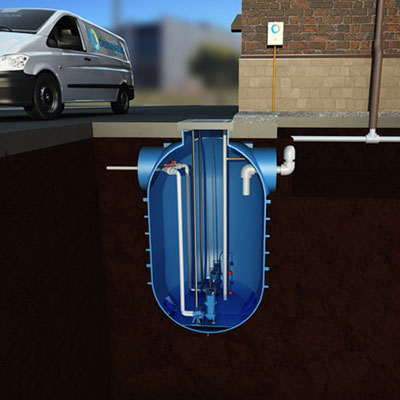Solve the problem of ponding surface water with a stormwater pump station
In an ideal world, stormwater washes off the surface of a carpark, residential or commercial area, flows into a stormwater system, and is discharged into a municipal system.
Yet, despite our best efforts, sometimes the ideal is out of reach. There may be not enough gradient in the land to create the gravity flow towards the municipal system, or the ground may be water charged causing groundwater ingress into the drainage system.
Stormwater pump stations are a key solution to the problem of stormwater drainage. For expert advice on installing and maintaining a system for your business, contact Cleanawater.
What is a stormwater pump station?
 A stormwater pump station is an intermediate collection tank for stormwater with a submersible pump at the bottom. Instead of relying on gravity to cause the water to flow to the discharge point, the pump provides the additional pressure needed to overcome the difference in head pressure.
A stormwater pump station is an intermediate collection tank for stormwater with a submersible pump at the bottom. Instead of relying on gravity to cause the water to flow to the discharge point, the pump provides the additional pressure needed to overcome the difference in head pressure.
All the stormwater collection points from a carpark, residential, commercial or industrial area are piped to an underground pump station. When the level in the pump station tank rises, the pump turns on and pumps the water out to the discharge point, even if that point is at higher than the level of the pump station.
In this way, the stormwater pump station prevents water ponding on a carpark surface creating a hazard for drivers and damaging the surface. The drainage infrastructure must be engineered correctly or stormwater has nowhere to go: meaning an area will flood when it rains. Pump stations are used when the expected flow rates cannot drain via gravity to the legal discharge point.
Who needs a stormwater pump station and why?
Any organisation that needs to process stormwater generated by rain may need a stormwater pump station to overcome problems of drainage and flow. Specific applications are:
- Carparks
- Workshops
- Any commercial or industrial applications that pump water to a discharge
- Large open areas
- Rural areas where infrastructure is often inground or below stormwater networks
From a regulatory perspective, stormwater must meet municipal requirements. A pump station can assist companies to take corrective action before the water is released to the municipal system in the case of an incident.
What should I consider when installing a stormwater pump station?
Cost
Stormwater pump stations are installed underground and thus need excavation. Although they can be installed in any ground conditions, some conditions are more difficult to excavate (like rocky or water charged ground) and therefore costlier. Larger pump stations can be installed horizontally to reduce the depth of excavation required.
Power
As stormwater pump stations need electricity for the pump, they must be installed in locations where there is access to power. Consideration should also be taken of the accessibility of the site to perform routine maintenance on the pump station.
Monitoring
Automation systems are integral to a stormwater pump station to start and stop the pump depending on the level of water in the tank. Monitoring equipment can also be installed to notify someone of a failure in level instrumentation or the failure of the pump to start. Remote monitoring is available for regional areas, while control panels and alarms are standard accessories for systems above 250-litre capacity.
What size pump station do I need?
Many factors influence the design size of the pump station capacity needed. The primary factors are the invert level on the pump chamber, water holding capacity time and risk and pump flow rate to evacuate the water levels. The larger the area and the heavier the expected rainfall, the larger the collection tank that will be required.
There are also other factors, which must be taken into account when determining a pump capacity. If there is a long discharge pipe leading to the discharge point, friction losses build up in the system as the water flows through bends and fittings etc. A pump must be sized to overcome these friction losses as well as the difference in head between the stormwater pump station and the discharge point.
The smallest pump stations are 40 litre under sink options for restaurant or kitchen applications, while the largest units are up to 30,000 litres. For capacities above 900 litres, dual pumps are provided for redundancy.
Contact Cleanawater for more information about stormwater pump stations
We offer technical expertise, excellent quality equipment and a personalised approach to your business’ needs. We can combine our solutions to suit your specific business, compliance and investment requirements.
Find out more about stormwater pump stations by contacting our expert team. We can arrange a consultation for your stormwater pump station needs and ensure that you keep compliant with regulations.
Must Read
What to Expect During a Modular Wash Bay Installation
CleanaWater, we make the process of installing a modular wash bay on your site as smooth and straightforward as possible. ...
Read moreThe CleanaWater Team Driving Water Treatment and Sustainability
CleanaWater is powered by a dedicated team of professionals who bring expertise and passion to every project. ...
Read more